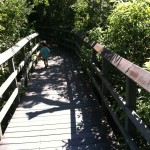 In 1916, the wild Cypress Creek wetlands of Coconut Creek, Florida were drained. This morning, I drive to Fern Forest Nature Center to visit the 247 acres of what remains. I want my 22-month-old son and to see our south Florida homeland untouched by housing developments, strip malls, and busy roadways.
In 1916, the wild Cypress Creek wetlands of Coconut Creek, Florida were drained. This morning, I drive to Fern Forest Nature Center to visit the 247 acres of what remains. I want my 22-month-old son and to see our south Florida homeland untouched by housing developments, strip malls, and busy roadways.
I park and help my little one out of the car seat. He wants to bring his “truck book” along. So, I tuck it in my backpack knowing that soon he’ll be mesmerized by tall trees, spider webs, and fish swimming in streams. It’s true. As soon as we begin walking in the woods, a calm energy surrounds us. He goes at a slow pace, soaking it all in.
“Mama!” he points to spiders above and fish below. He never once asks for the book.
It is toddler time at the nature center. We sit in a circle of women and little ones. The focus today is arachnids. My son alternates between nursing, sitting on my lap, and standing to watch the facilitator read a colorful book about eight legged wonders. She turns to the picture of a scorpion. Something like “Aahharrah!” erupts from my little one’s lips. He stands with eyes wide. His primal sound of wonder joins the articulation of a little finger pointing to the photo. We all laugh.
Soon, the groups sets forth for a “Let’s look for spiders!” walk. I admire the free spirit in my son who sets his own pace. He notices all sorts of little spider webs along the side of the trail. Soon, the group is far ahead of us. We meander and take our time. We are joined by a dear friend and her 3 ½ year old son.
The boys begin to play. They run, blow on spider webs, share an apple, laugh hysterically, point to trees, and hold hands. My friend and I talk about the healing tonic in wild lands, the need to consume less, and the importance of slowing down the pace of modern life to remember what matters most.
Collectively, we are raising a generation of children who spend most of their time inside playing with plastic toys that beep. They spend far too much time watching screens blast mind-numbing images of great speed and intensity. They consume large quantities of processed food. Breastfeeding rates for toddlers, a norm practiced throughout human history, are abysmally low in our culture. What does this do to the developing brain? Certainly it does little to nurture a connection to the remaining wild places that desperately need protection in our world.
To watch nature unfold, one needs patience not a sugar-induced euphoria. One needs an eye for careful detail and a heart open to simple beauty in order to truly admire the wonder at work when a spider spins her web. Repetitive beeping toys do not elicit such skills. When I think about this, I feel so sad.
We may debate the specifics, but what I know is this. Our world would be a gentler and healthier place for all children if we lived more simply, bought fewer plastic gadgets, spent more time in wild lands, let little ones nurse freely, and marveled in awe at arachnids each day.
We drive home on the asphalted graves of wetlands. The immense biodiversity just witnessed is reduced to miles and miles of roadway. These roads link our world, our commercial structures, our homes and lives. They also link us to what remains of wilderness. I breathe deeply.
May we do what we can to protect what is natural within the human spirit and within our world.
